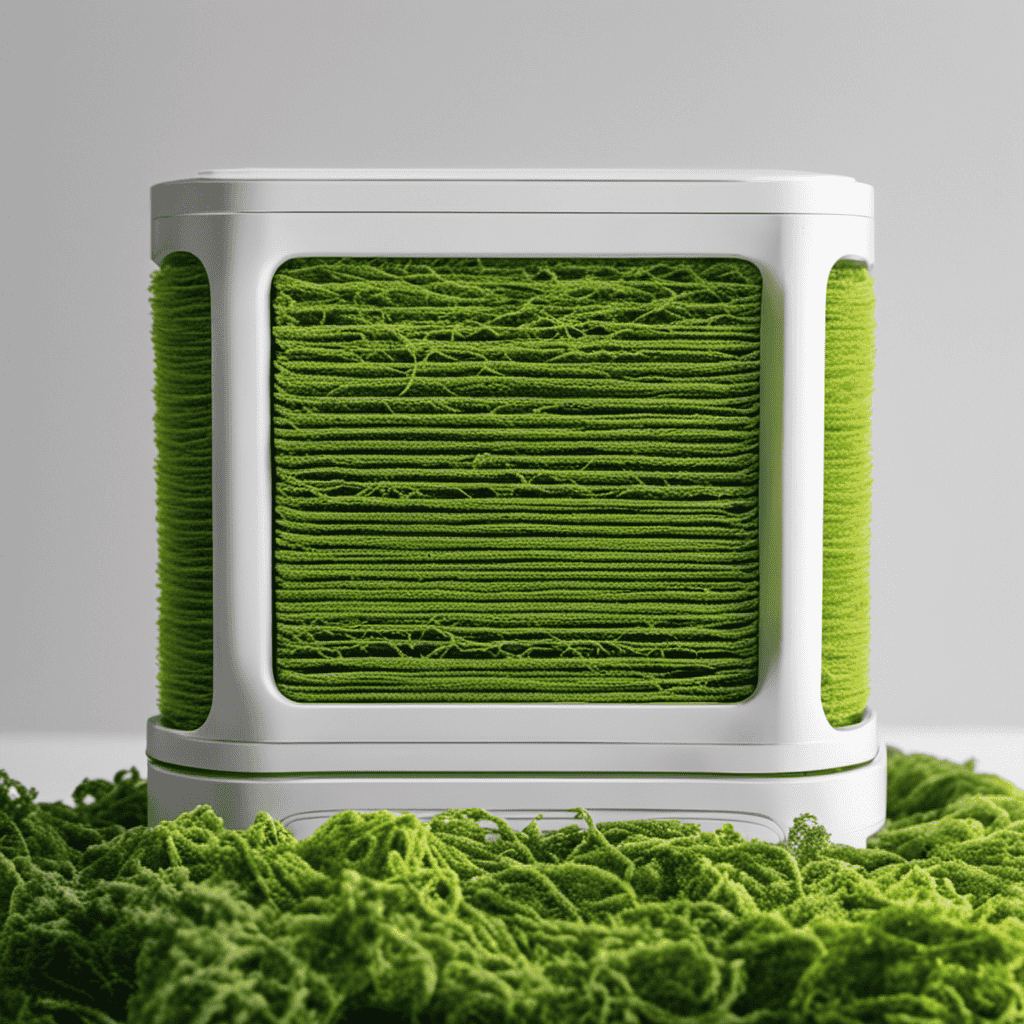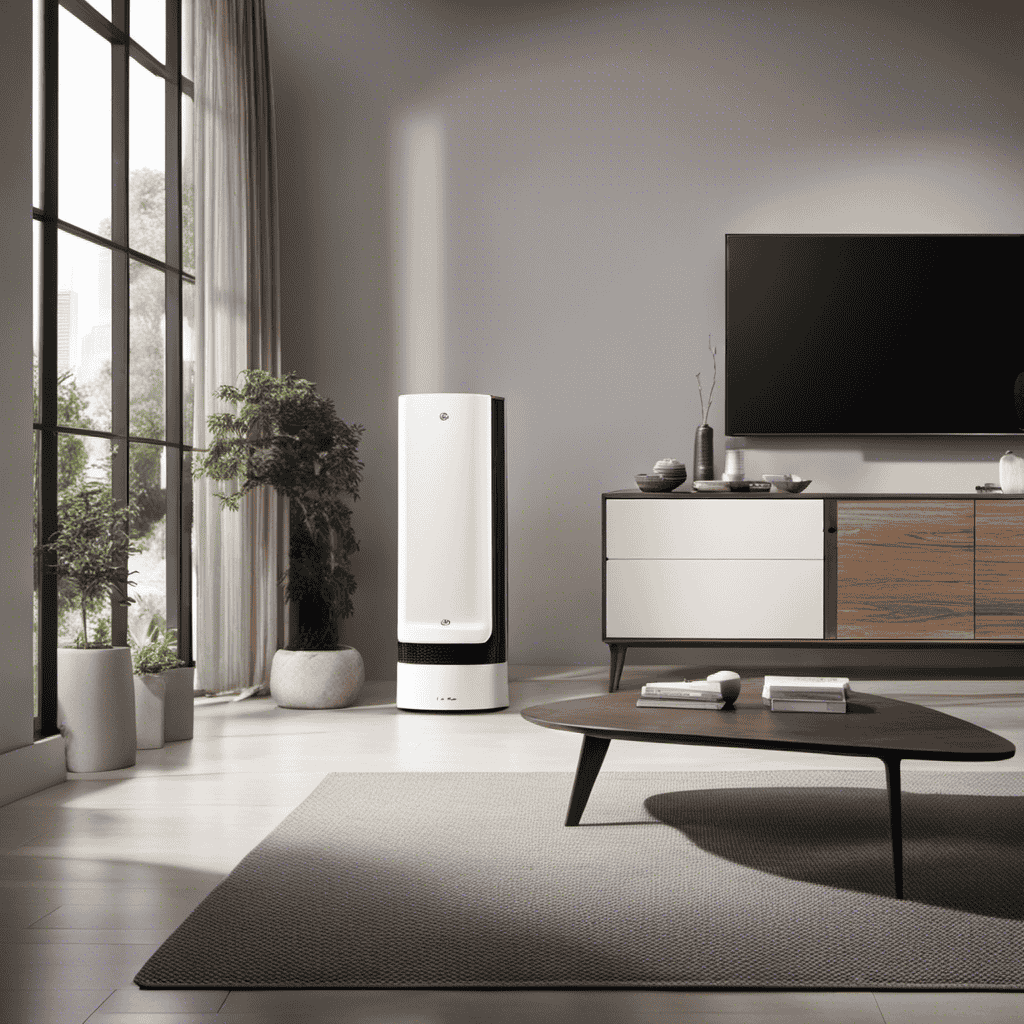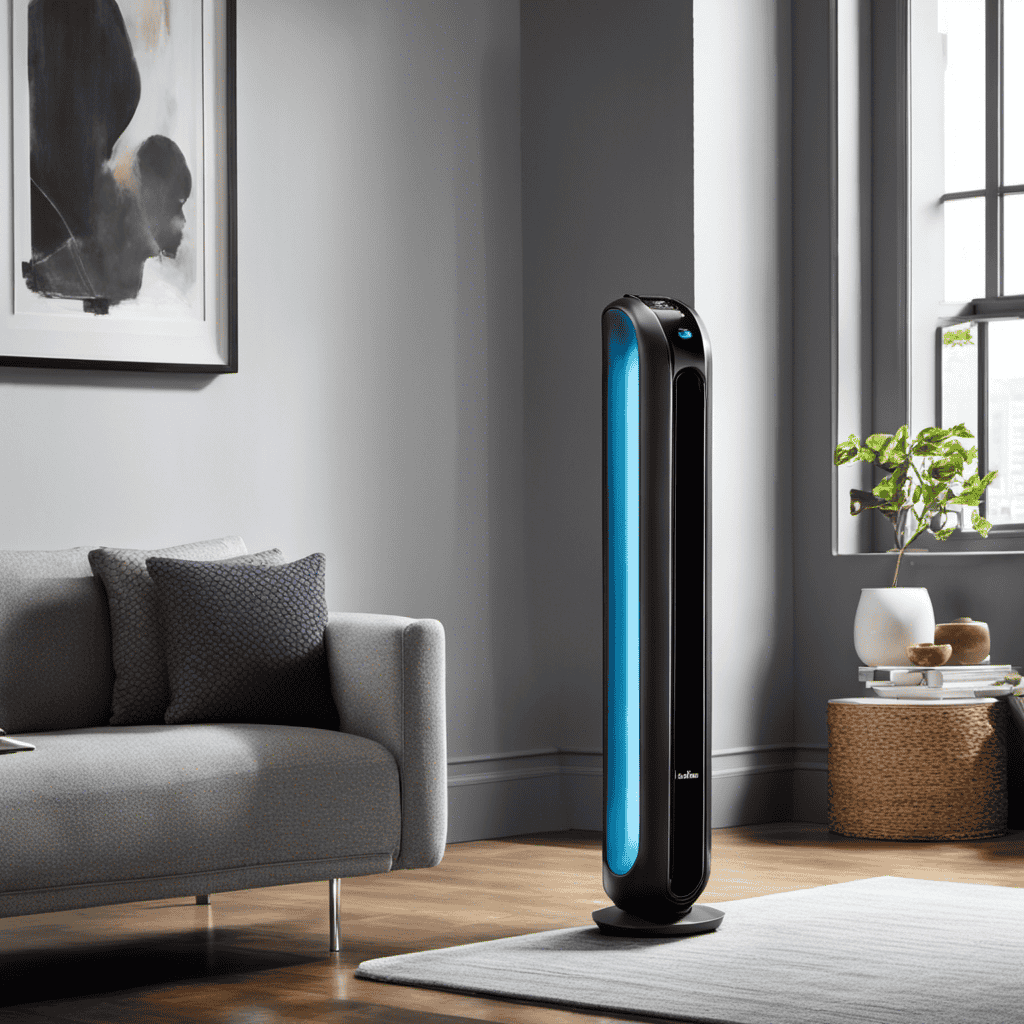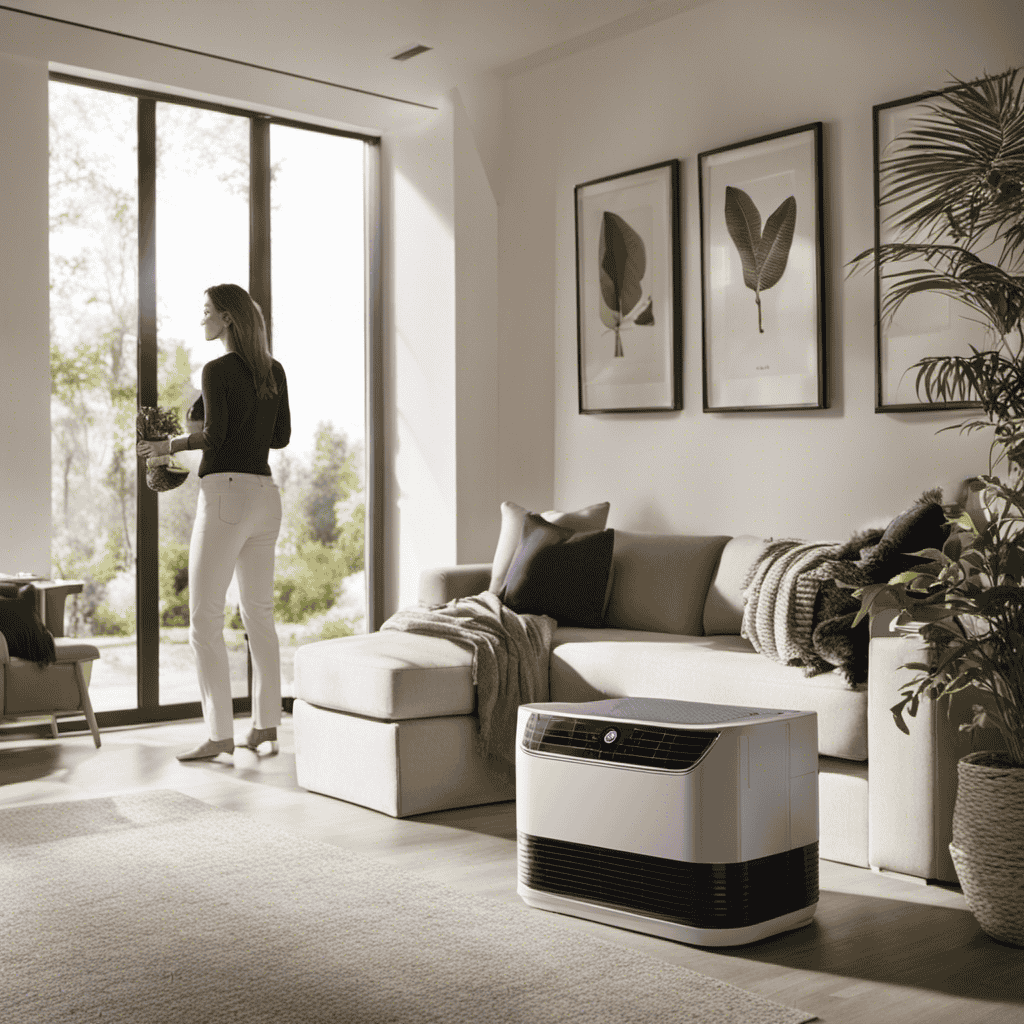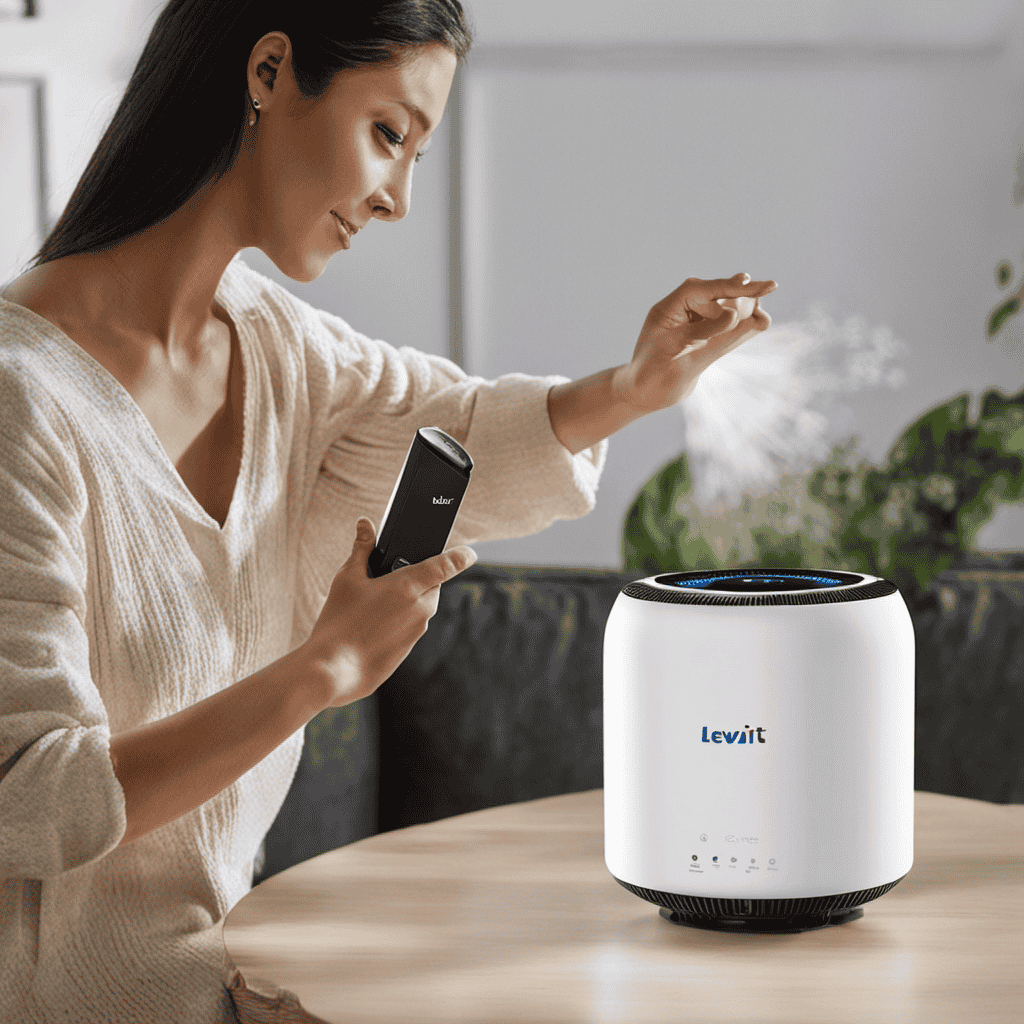As I delve further into the air purifier universe, there’s a question that continuously haunts my thoughts: when an air purifier captures mold spores, do those spores remain alive within the filters?
In this article, we will explore the mechanism of air purifiers in trapping mold spores and delve into the lifespan of these spores in air filters. By understanding the factors affecting their survival and evaluating the efficacy of air purifiers, we aim to shed light on the potential risks and provide tips for proper maintenance.
Let’s uncover the truth behind mold spores in air purifier filters.
Key Takeaways
- Air purifiers, particularly those using HEPA filters, can effectively trap mold spores.
- Mold spores can remain viable in filters if they retain moisture, highlighting the importance of regular filter maintenance.
- Cleaning methods such as vacuuming, washing with mild soap and water, and using compressed air can help remove trapped particles from the filter.
- Mold spores trapped in filters can pose health risks, including allergic reactions, respiratory issues, and fungal infections, emphasizing the need for proper cleaning and maintenance of air purifier filters.
The Mechanism of Air Purifiers in Trapping Mold Spores
Air purifiers use filters to trap mold spores, preventing them from spreading further. These filters are designed to capture particles as small as 0.3 microns, which includes most mold spores. As the air passes through the filter, the mold spores become trapped within the fibers.
The effectiveness of air purifiers in removing mold spores depends on the type of filter used and its filtration efficiency. High-efficiency particulate air (HEPA) filters are considered the most effective in removing mold spores from the air.
However, it is important to note that while air purifiers can trap mold spores, they do not kill them. Understanding the lifespan of mold spores in air filters is crucial in maintaining the cleanliness and efficiency of the purifier, which will be discussed in the subsequent section.
Understanding the Lifespan of Mold Spores in Air Filters
When it comes to air filters and mold spores, one important aspect to consider is the viability of these spores. How long can they survive in the filters? This question is crucial in understanding the effectiveness of filter cleaning methods and the potential health risks associated with mold spore exposure.
In this discussion, we will delve into the lifespan of mold spores in air filters. We will explore different filter cleaning methods and highlight the potential health risks that may arise from the presence of these spores.
Mold Spore Viability
You might be wondering if the mold spores are still alive after they get trapped in the filters. Well, let me provide you with some insights.
When mold spores are captured by air purifier filters, their survival depends on various factors. Here’s what you need to know:
-
Humidity: Mold spores thrive in moist environments, so if the filters retain moisture, the spores may remain viable.
-
Filter Maintenance: Regularly cleaning or replacing filters can help prevent the accumulation of mold spores and reduce their survival chances.
-
Filter Material: Certain filter types, like HEPA filters, are designed to trap even the smallest particles, including mold spores. Their efficient filtration can significantly impact the survival of mold spores.
It’s important to note that while filters can capture mold spores, proper filter maintenance is crucial to minimize their viability and prevent their release back into the air.
Filter Cleaning Methods
To keep your air purifier working effectively, make sure to regularly clean or replace its filters. Filters play a crucial role in capturing and trapping airborne particles, including mold spores. Over time, these filters can become clogged with trapped mold spores and other pollutants, reducing their efficiency. Cleaning or replacing the filters is essential to maintain optimal performance. When it comes to cleaning filters, there are several techniques you can use. These include vacuuming the filters, washing them with mild soap and water, or using compressed air to blow away the trapped particles. However, not all filters are washable or reusable, so it’s important to check the manufacturer’s instructions. If the filters are not washable, they should be replaced according to the recommended schedule. Regular filter replacement or cleaning will ensure that your air purifier continues to effectively remove mold spores and other contaminants from the air you breathe.
| Filter Cleaning Methods | Advantages |
|---|---|
| Vacuuming | Removes loose particles and dust effectively |
| Washing with soap and water | Thoroughly cleans the filter |
| Using compressed air | Blows away trapped particles from the filter |
| Replacing the filter | Guarantees optimal performance |
| Following manufacturer’s instructions | Ensures proper cleaning and maintenance |
Health Risks Associated?
There are potential health risks associated with not regularly cleaning or replacing your air purifier’s filters. Mold spores can accumulate in the filters over time, posing a risk to your health if not properly cleaned or replaced.
Here are three risks and prevention methods to consider:
-
Allergies: Mold spores trapped in the filters can trigger allergic reactions, causing symptoms like sneezing, coughing, and itchy eyes. Regularly cleaning or replacing the filters can help reduce the presence of mold spores and alleviate allergy symptoms.
-
Respiratory issues: Inhaling mold spores can irritate the respiratory system, leading to respiratory problems such as wheezing, shortness of breath, and asthma attacks. Keeping the filters clean and replacing them when necessary can help prevent these issues.
-
Infections: Mold spores can also cause fungal infections, especially in individuals with weakened immune systems. Proper maintenance of air purifier filters can minimize the risk of fungal infections.
Regularly cleaning or replacing your air purifier’s filters is crucial to prevent these health risks associated with mold spores.
Now let’s explore the factors that can affect the survival of mold spores in air purifier filters.
Factors Affecting Mold Spore Survival in Air Purifier Filters
When it comes to the lifespan of mold spores in air filters, there are various factors that can affect their survival.
One key point to consider is the viability of mold spores, as some spores may be more resilient and able to survive longer in the filters than others.
Additionally, the impact of filter maintenance cannot be overlooked, as regular cleaning and replacement of filters can help prevent the buildup of mold spores and ensure the effectiveness of the air purifier.
Mold Spore Viability
You might be wondering if mold spores are still alive in the filters of your air purifier. Well, here’s some information to help you understand the viability of mold spores in air purifier filters.
-
Mold spore reproduction: Mold spores are reproductive units of mold that can grow and reproduce when they find suitable conditions. However, in air purifier filters, the lack of moisture and nutrients makes it difficult for mold spores to reproduce.
-
Mold spore deactivation: Air purifier filters are designed to capture and trap mold spores, effectively deactivating them. The filters can physically remove the spores from the air, preventing them from spreading and causing further contamination.
-
Viability of trapped mold spores: While mold spores may still be present in the filters, they are typically rendered inactive and unable to cause further mold growth. Regular maintenance and filter replacement ensure that trapped mold spores do not become a source of contamination.
Filter Maintenance Impact
Regular maintenance of your air purifier’s filters is crucial for maintaining their effectiveness in deactivating and preventing the growth of mold spores.
Mold spores can be trapped in the filters, but it is important to understand that they are not completely eliminated. While the filters are designed to capture and hold these spores, they can still remain alive within the filter material.
This is why regular filter replacement is necessary to ensure the continued efficiency of the air purifier in eliminating mold spores.
Mold prevention measures should also be implemented alongside filter maintenance to address the root cause of mold growth in your environment. These measures may include controlling humidity levels, fixing any water leaks, and improving ventilation.
Evaluating the Efficacy of Air Purifiers in Eliminating Mold Spores
The effectiveness of air purifiers in removing mold spores can be evaluated by examining whether they are still alive in the filters. To assess this, consider the following:
-
Visual inspection: Look for any visible signs of mold spores in the filters. This may include discoloration or growth on the filter surface.
-
Microscopic analysis: Use a microscope to examine the filters for the presence of live mold spores. This can provide a more accurate assessment of their viability.
-
Air quality testing: Conduct air quality tests before and after using the air purifier to determine the reduction in mold spore levels. This can help gauge the overall effectiveness of the device in removing mold spores from the air.
By evaluating these factors, we can determine whether air purifiers are successfully removing and eliminating mold spores.
However, it’s important to also consider the potential risks of mold spores residing in air purifier filters.
Potential Risks of Mold Spores Residing in Air Purifier Filters
Potential risks of mold spores residing in air purifier filters include the spread of spores back into the air when the filters are not properly cleaned or replaced. Mold spores are microscopic particles that can cause various health implications when inhaled.
When mold spores are trapped in the filters of an air purifier, they can continue to survive and multiply if not addressed adequately. Cleaning techniques are essential to prevent the buildup of mold spores in the filters.
Regularly cleaning or replacing the filters is crucial to maintain the effectiveness of the air purifier and minimize the risk of spore recirculation. Failure to properly clean or replace the filters can lead to the release of mold spores back into the air, potentially causing respiratory issues, allergies, and worsened symptoms in individuals with pre-existing conditions.
Therefore, it is important to follow proper cleaning techniques and regularly monitor and maintain air purifier filters to ensure a healthy indoor environment.
Tips for Properly Maintaining Air Purifier Filters to Prevent Mold Growth
To properly maintain your air purifier and prevent mold growth, make sure you regularly clean or replace the filters. Here are three important tips to help you keep your air purifier filters in top condition:
-
Regular cleaning: Dust and debris can accumulate on the filters, reducing their effectiveness and providing a breeding ground for mold. Use a soft brush or vacuum cleaner to remove any visible dirt and particles from the filters.
-
Filter replacement: Over time, filters become clogged and lose their ability to trap mold spores effectively. It’s recommended to replace the filters according to the manufacturer’s instructions to ensure optimal performance and prevent mold growth.
-
Monitor humidity levels: High humidity can promote mold growth, even on clean filters. Use a hygrometer to monitor the humidity levels in your home and consider using a dehumidifier to maintain a humidity level below 50%.
By following these tips, you can minimize the risk of mold growth in your air purifier filters and maintain clean air in your home.
Now, let’s explore alternative methods to dispose of mold-infested air purifier filters.
Exploring Alternative Methods to Dispose of Mold-Infested Air Purifier Filters
If you’re looking for alternative methods to dispose of your mold-infested air purifier filters, consider contacting your local waste management facility for guidance. They can provide you with specific instructions on how to handle and dispose of these filters safely and responsibly.
When it comes to disposable filter options, there are a few techniques you can explore. One option is to seal the mold-infested filters in a plastic bag before disposing of them in your regular trash. This helps to prevent the release of mold spores into the air.
Another technique is to use a specialized mold spore disposal bag, which is designed to contain and trap the spores during disposal.
Remember to always follow proper safety precautions and guidelines when handling mold-infested materials to protect yourself and others from potential health risks.
Frequently Asked Questions About Mold Spores in Air Purifier Filters
Have you ever wondered how long mold spores can remain in your home after using disposable filters? When it comes to filter replacement and mold spore removal, it’s important to understand the lifespan of these spores.
Here are a few key points to consider:
-
Mold spores can survive in air purifier filters for a significant amount of time, even after the filter has been removed from the purifier.
-
The exact duration can vary depending on factors such as humidity levels, temperature, and the type of mold present.
-
It is recommended to replace air purifier filters regularly to minimize the risk of mold spore recirculation and potential health issues.
Frequently Asked Questions
Can Mold Spores Survive in Air Purifier Filters?
Yes, mold spores can survive in air purifier filters. Regular air purifier maintenance is crucial to prevent the buildup of common mold spores, ensuring the filters remain effective in trapping and removing them from the air.
How Long Can Mold Spores Survive in Air Purifier Filters?
When an air purifier traps mold spores, they may still be living in the filters. However, over time, the filters can reduce the spores’ viability and improve long-term air quality by preventing them from being released back into the environment.
Are There Any Factors That Can Affect the Survival of Mold Spores in Air Purifier Filters?
There are several factors that can affect the survival of mold spores in air purifier filters. One important factor is moisture, as it can impact the viability of the spores in the filters.
How Effective Are Air Purifiers in Eliminating Mold Spores?
Air purifiers are highly effective in reducing mold spores, improving indoor air quality, and preventing mold growth. They capture and trap the spores in filters, preventing them from circulating and multiplying in the air.
Are There Any Potential Risks Associated With Mold Spores Residing in Air Purifier Filters?
Yes, there are potential risks associated with mold spores residing in air purifier filters. Mold spores can continue to grow and multiply in the filters, potentially releasing more spores into the air.
Conclusion
In conclusion, it is important to understand that when an air purifier traps mold spores, they can still be alive in the filters. The lifespan of mold spores in air filters can vary depending on several factors, including humidity levels and the type of mold.
While air purifiers can effectively eliminate mold spores, there is a potential risk of mold spores residing in the filters. To prevent mold growth, proper maintenance of air purifier filters is crucial.
It is recommended to explore alternative methods for disposing of mold-infested filters to ensure a healthy environment. Remember, prevention is better than cure.
